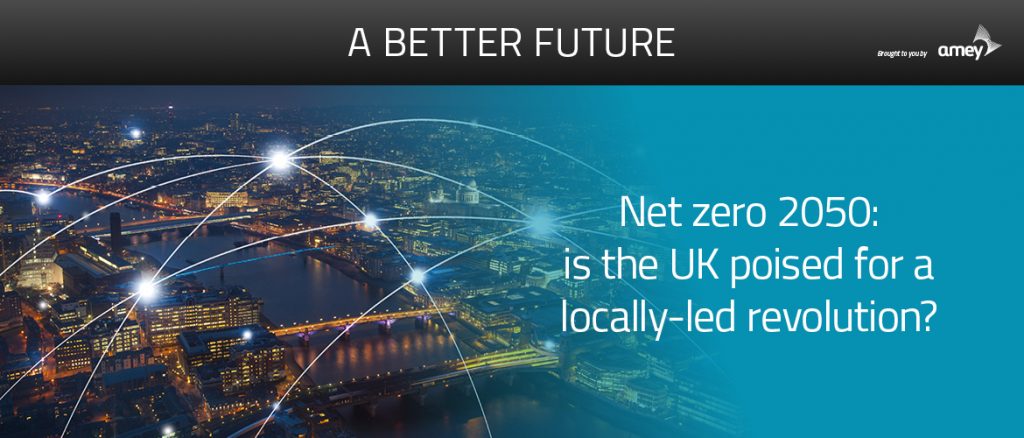Amey calls for urgent action to decarbonise the UK’s built environment

Amey has today published its second white paper on the UK infrastructure market. Focusing on the need for urgent, wide-ranging action across the public and private sectors to decarbonise energy and heating in the UK’s built environment, Amey makes three core recommendations and calls for immediate action if the UK government is to reach its Net Zero targets by 2050. The three recommendations are:
- Clear and consistent government policy to steer the market in the direction of low carbon technologies.
- Clear investment models so that local authorities are better equipped to engage with the market and investors can invest with more confidence.
- Local authorities and central government organisations empowered to make decisions by having in place business models and funding that work for them.
Amey sets out the stark challenges ahead, making the point that heat accounts for 31% of the UK’s greenhouse gas emissions and there are just three decades remaining to reach a target of Net Zero emissions by 2050, which the government legally committed to in June 2019. The required scale of investment by government and the private sector, the report says, is immense, while the roll-out of decarbonising technologies will need to be rapid and supporting by considerable government policy.

Commenting, Nick Maggs, Business & Development Director, Amey, said: “Notwithstanding initiatives such as recent consultations on heating in Scotland and the Heat Network Investment Project, the public and private sectors need to move much faster. In the case of heat networks, there is a lack of understanding of how the technology works and very little publicly available information or policy from the Government backing this and other carbon saving technologies. Heat networks and district heating schemes which significantly reduce carbon emissions only deliver about 2% of UK heat currently. There is huge potential to act on the technologies that are already available – opportunities that we as a country have not yet fully grasped.”
The white paper suggests that the size and scale of the investment required means it is essential that local authorities and government departments use business models that encourage a plethora of market entrants, which in turn will lead to strong competition that will drive down prices and deliver technical innovation. There is also a call for standardisation around technology, corporate funding structures and around the process of due diligence. This approach would overcome some of the difficult commercial and technical challenges and would enable the market to move forward and accelerate third party funding.
Amey points out that despite over 100 local authorities having declared a climate emergency and many of them making good progress in their stated carbon neutral targets, many still lack the guidance and policy clarity from central government on what carbon saving approaches are permissible and possible. Given the urgency of the task ahead, Amey urges a revamped and much stronger relationship between local and central government. At the same time, Amey emphasises that there is an abundance of private sector companies ready to invest in the market if there are clear, stable, investable structures that allow them to finance new developments and if they can understand where funding comes from to repay their investment when projects are successfully delivered.
Core to Amey’s recommendations is for less fixation on achieving off balance sheet classification for contracts between the public and private sectors. Trying to ensure private sector concessions are off balance sheet in other infrastructure sectors has led to inflexible contracts, too much risk transfer and the inability to adopt models which are more collaborative between the public and private sectors. Amey believes that past mistakes in balance sheet treatment of infrastructure projects need to be avoided in energy and heating infrastructure.
Nick Maggs added: “Central government departments such as the Ministry of Defence, Ministry of Justice and the NHS are fertile ground for implementing major heating and energy efficiency schemes that can have immediate effects – financial savings as well as carbon reduction. Without the complexities faced by local authorities of disparate households and businesses, departments can implement more radical solutions, more quickly on their estates. They face similar challenges around balance sheet treatment and business models as their local government counterparts. Yet the scale of the investment required will attract investors prepared to take risk on delivery, savings and energy efficiency – departments are likely to benefit from a highly competitive market.”
Finally, Amey points out that the supply chain needs to be fully resourced and trained with knowhow and skills in low carbon technologies to move forward with the scale of the transition needed. This requires strong government backing and follow through to ensure that the supply chain serving the public sector can fully advise decision-makers on the solutions available and have the technical expertise to deliver low carbon solutions.
